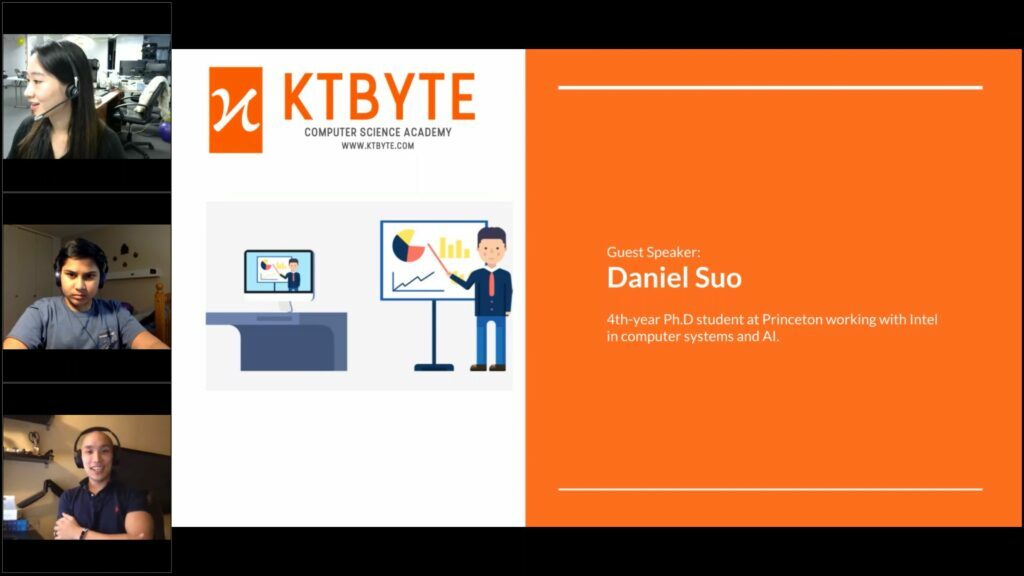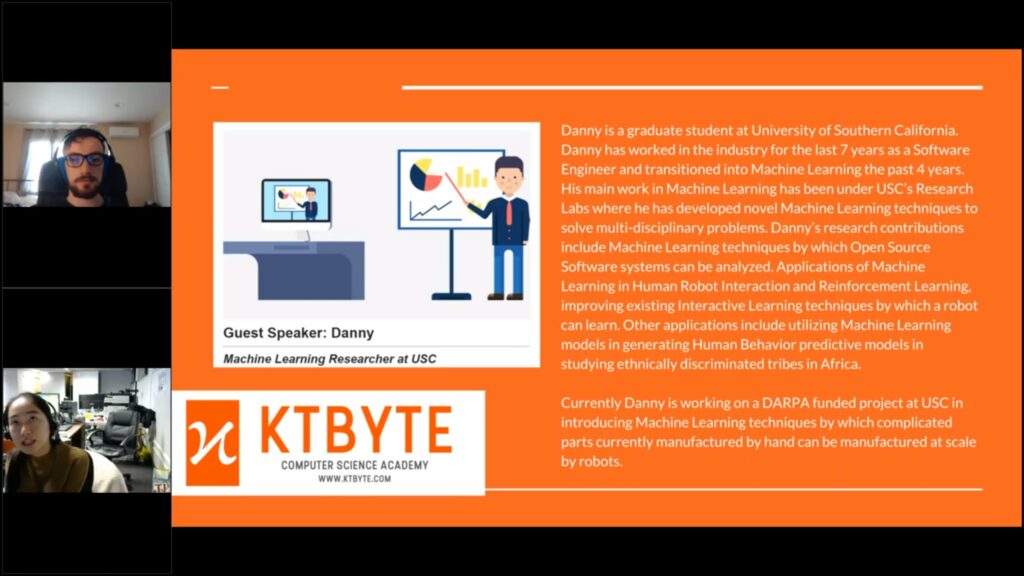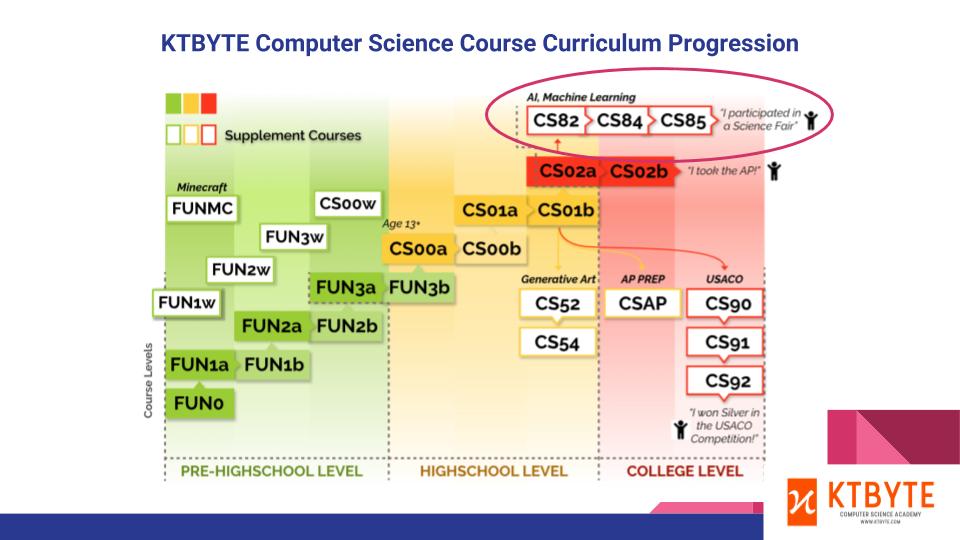Find a Camp

Research is something of a buzzword these days. It's one more thing on a resume for a high-achieving university student, needed for businesses and companies, and wanted by graduate schools who are searching for candidates. How exactly does research manifest itself in the work of a computer scientist?
Even students may be interested in figuring out how to begin a research project at a young age. One popular program, MIT PRIMES, offers research projects to high school students. They'll get to work with MIT researching new, unsolved problems in mathematics, CS, and computational biology. There have been over 20 KTBYTE students accepted in the past, and one of the best ways to get in this selective program is by getting research experience early on.
As we can see, there are several examples of people who complete research as part of their jobs. Below, we'll summarize two KTBYTE webinars featuring some current Ph.D. students, one of which is a teacher here. Through these interviews, we'll unpack just what it means to research in the computer science field.
DANIEL SUO, PRINCETON PH.D. CANDIDATE

In Daniel Suo's words, research is to“discover new things…that people didn't know before.”As a researcher, he gets to deal with the more technical aspect of computer science, analyzing data and running tests on a day to day basis. At Princeton, he's working with professors and other researchers to pursue his own interests in generating knowledge to advance the field.
Of course, doing research isn't always easy. Unlike reading textbooks that emphasize the largest achievements of the past centuries, research doesn't come as easily. Part of researching involves many different tries, to try out small experiments and tweak them until they work. However, Suo believes the job is more than fulfilling by helping guide future researchers towards the next big idea.
He views his research the way most people might view a“silicon-valley”startup. With the limitless power that CS might offer, every experiment that he runs and tests adds on to knowledge in the world. As a researcher of distributed systems, he tries to expand theories and ideas to all fields beyond just computer science. With the versatile role that CS plays, he's able to work on smaller details and parts, slowly growing closer to the solution.
DANNY, UNIVERSITY OF SOUTHERN CALIFORNIA PH.D. CANDIDATE

Danny has been working on developing new machine learning techniques to solve issues across all fields and sectors. He's been introducing novel ways to analyze Open Source Software systems, looking at interactive learning techniques for robots, and even figuring out reinforcement learning. Currently, he's working on a DARPA funded project at USC and dealing with how robots can manufacture complicated parts in factories.
He agrees with Daniel Suo when it comes to the difficulties that research can bring. While there may be a lot of failures, each just brings you one step closer to the final solution. Research involves a lot of application of prior knowledge, figuring out what techniques to use on new problems and ideas through what they have already studied. In addition, research experience is a huge advantage when it comes to applying for graduate schools and getting further in academia.
Danny is also a KTBYTE instructor, teaching AI classes to students. As someone with first-hand experience on how machine learning is used in the industry and advanced through research, he knows how to explain the basics well to kids, no matter what age they are. While students may be limited in hardware and generating data for AI, he can help students work around that and develop their understanding of this niche.
KTBYTE RESEARCH COURSES

With research being such a large part of academia, we have courses that expose students to this at a younger age than their peers, giving them a head start. For example, CS82 Intro to Machine Learning is a class that teaches students the tools to model and understand complex data sets. They begin dealing with“Big Data”problems and gain exposure to supervised and unsupervised learning. While it is math-heavy, it gives a strong foundation and introduction to what they could accomplish as a CS researcher.
CS84 is the Deep Learning course, which teaches students the modern techniques for supervised learning. This involves technology such as facial and speech recognition, and is the basis for how self-driving cars may operate. One benefit is that students will gain access to a Linux server with GPU acceleration to run and test their algorithms, which is professional research-grade hardware. This opportunity may be difficult to find elsewhere. Students get to deal with more complexities that data sets may offer and even get to work on attaining data sets on their own, figuring out how to best deal with it.
The final research course offered is CS85, titled Practicum in Artificial Intelligence. This course is based on a student working on a single, large research project. They get the opportunity to contribute something novel to the CS field, collecting data they need on their own. Without problem sets, students instead get to focus on completing their research paper or presentation, allowing them to gain a deep understanding of machine learning through self-driven curiosity and intellection.
PAST RESEARCH PROJECTS
With so many students having taken CS85 in the past, below are some of the more intriguing research projects that they have completed. This was done through their own interest, with KTBYTE instructors providing guidance when needed. Some students such as Pratik Bharadwaj worked on image augmentations, publishing one paper on the impact of information loss and another on improving deep-learning accuracy of diagnosing breast cancer.
Arnav Bansal is another student who created a paper that used a deep convolutional neural network to predict air pollution levels. Jonathan Lei spent his semester pinpointing factors that led to suicide and creating a machine learning suicide prediction project. A fourth student, Andrea Danila had a more lighthearted research project, distinguishing between the source text and fanfiction through a neural network. You can find more research projects here.
CONCLUSION
It's never too early to get started on research, even before your child has gotten to college. With the boundless opportunities that research offers, it's best to help them explore this area early on so that they'll know if they're interested or not. It piques their curiosity as they get to focus on a topic that's interesting to them, and before long, they'll be working on their own paper in our CS85 class.
Whether they want to go to graduate school or not, research plays a large role in corporations and jobs just as much as it plays a role in academia. It increases human knowledge of the area and can lead to amazing discoveries that could change the world. With research, your child's application to colleges and prestigious programs are sure to stand out.